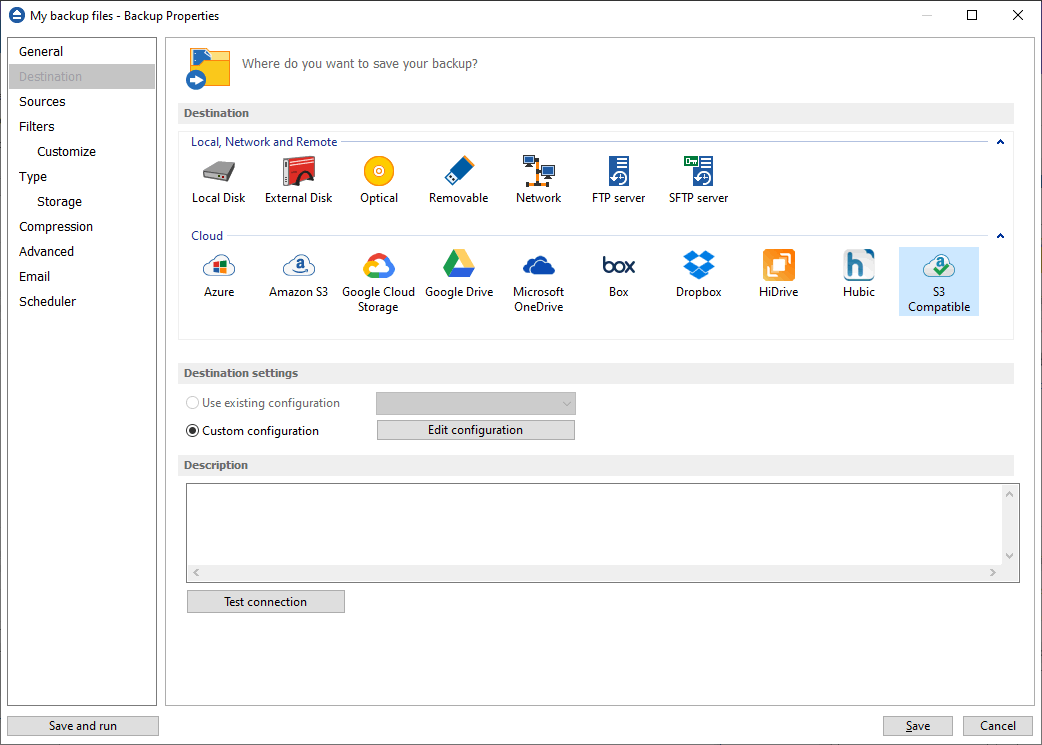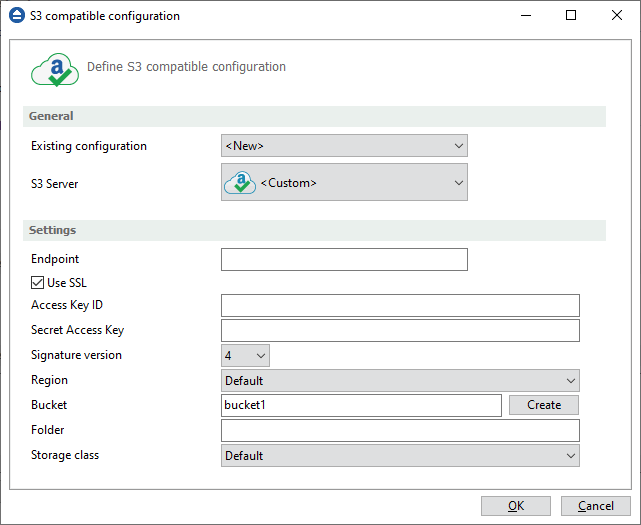Backup4all supports backing up to S3 Compatible storage. This is a practical backup destination because the backed up data can be easily accessed from any other computer with an Internet connection.

Destination
Use existing configuration
Use this option if you want to use an already defined S3 Compatible location in File->Options->Online connections->S3 Compatible. From the drop-down list, select the S3 Compatible location you want to use.
The advantage is that if you use the same S3 Compatible destination for multiple backup jobs and a modification is needed for destination, you can change only the S3 Compatible configuration from File->Options->Online connections->S3 Compatible and all backup jobs destinations will be updated.
Custom configuration
Use this option to add a new S3 Compatible location or to edit an existing one by pressing the Edit configuration button.
Description
Here you can see a listing of the S3 Compatible settings.
If you configured a new S3 Compatible location or you edit an existing one, you should use the Test connection button to see if the S3 Compatible settings are correct. If the test was successful, The S3 Compatible connection was tested successfully message will be displayed.
Once you press the OK button, Backup4all will try to connect to the S3 Compatible server to see if a backup catalog already exists on the destination. If the S3 Compatible destination is not available, a Cannot connect to the S3 Compatible server message is displayed in the status bar (bottom of the main window).
This window is shown when selecting Edit configuration from the Destination->S3 Compatible window.

General
Existing configuration
If you want to add a new S3 Compatible location, the <New> option should be selected. To edit an existing S3 Compatible location, select it from the drop-down list. All fields will be filled with the values of the selected S3 Compatible configuration.
S3 Server
Select one of the predefined S3 compatible servers, or define a custom one. The S3 compatbile clouds available are: Akaza, Aruba Cloud, Backblaze B2, Caringo, CenturyLink, Cisco, Claudian, Connectia, Constant, DDN, dinCloud, Dream Objects, Dunkel, T Cloud, Exoscale, Green Qloud, HGST, Hitachi, HostEurope, IDC Frontier, LeoNovus, Mandic, Minio, NetApp, NiftyClouds, Numergy, QNAP, Revera, Scality, Seeweb, SwiftStack, ThinkOn, Tiscali, vCloud Air, Verizon, Walrus and Zettagrid.
Settings
- Endpoint - enter the server endpoint. For most of the predefined servers, the endpoint is filled automatically. Example: s3.akaza.lk:80
- Use SSL - select this option if the server requires SSL usage
- Access Key ID - enter the access key ID as received from your server provider
- Secret Access Key - enter the secret access key as received from your server provider
- Signature version - chose the signature version used by your server
- Region - select the region where your bucket is located
- Bucket - enter the name of the existing bucket or type a new one and press the Create button.
- Folder - In this field you have to select the folder where you want to store the backups. If no folder is selected the backup will be stored in the root of your S3 Compatible account.
- Storage class
- Standard - this option offers high durability, availability, and performance object storage for frequently accessed data.
- Standard - Infrequent Access Storage - is an Amazon S3 storage class for data that is accessed less frequently, but requires rapid access when needed.
- Reduced redundancy (not recommended) - enables customers to store noncritical, reproducible data at lower levels of redundancy than Amazon S3’s standard storage. It provides a highly available solution for distributing or sharing content that is durably stored elsewhere, or for storing thumbnails, transcoded media, or other processed data that can be easily reproduced.


